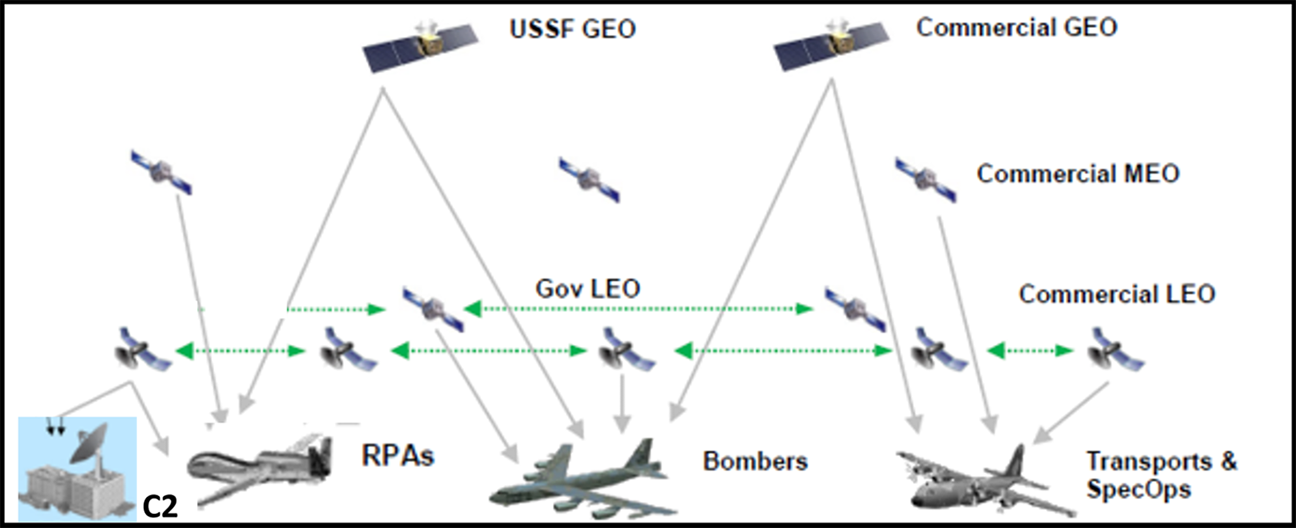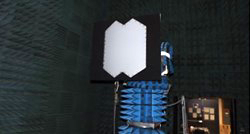GLOBAL LIGHTNING
MULTI-CONSTELLATION SATELLITE COMMUNICATIONS
GLOBAL LIGHTNING PROVIDES ROBUST SATELLITE COMMUNICATIONS BY:
- Connecting to the high-rate communications links of commercial constellations in LEO, MEO, and GEO
- Switching to military satellite constellations when unique or non-standard communication features are advantageous
- Testing and optimizing multi-constellation SATCOM terminals in a wide range of military applications
GLOBAL LIGHTNING – WHAT IS IT?
Global Lightning is a prototyping and experimentation campaign to provide reliable, secure satellite communications to both stationary and mobile users. The effort started in 2018 by testing communications through prototype satellites launched by emerging commercial space internet vendors, including SpaceX Starlink (precursor to Starshield), OneWeb, and Telesat. Initial testing validated the concept of using commercial proliferated low-earth orbit (pLEO) megaconstellations, each consisting of hundreds or thousands of spacecraft, to achieve high-datarate, low-latency, secure communications to DoD users. As the commercial networks rapidly evolved, AFRL’s Global Lightning team worked with partners from across the Air Force, Navy, Army, Coast Guard and Marines to achieve communications to several hundred ground users, ships, military vehicles and multiple aircraft types, including AC-130, KC-135, and others. These tests utilized “single-constellation” user terminals, meaning they were able to talk to, for example, Starlink or OneWeb, but not both. These iterative tests were successful and in 2023 hundreds of users are now applying the results in operations across the globe, including traditionally underserved areas like the Arctic where reliable satellite broadband service is now readily available from at least two commercial pLEO constellations.
The focus of the Global Lightning program has now advanced to the creation of multi-constellation systems capable of communicating with five to 10 commercial and military satellite communications systems in low-, medium-, and geostationary orbits (LEO, MEO, and GEO) across multiple frequency bands. We call this Hybrid SATCOM.
HYBRID SATCOM – HOW DOES IT WORK?
The concept behind Hybrid SATCOM is pretty simple: our warfighters’ satellite communications equipment should be able to work with any of the 10 to 50 satellites in their field of view at any given time. While the concept is simple, achieving it requires special equipment, modern networking techniques, and, most importantly, extensive testing and experimentation.
One of the key elements making Hybrid SATCOM possible is the recent advancement of highly-capable, affordable antennas. Because each individual satellite constellation requires different technical parameters for the associated user terminals – gain, transmit power, frequency, bandwidth, tracking speed, satelliteto- satellite handover rates, etc. – an antenna that communicates with multiple constellations must be both flexible and highperformance. In just the last few years, the technology to create such antennas has become available and affordable. The Global Lightning program is working with several antenna manufacturers to customize and test apertures capable of meeting the needs of LEO, MEO and GEO spacecraft across two or more frequency bands.
In addition to antennas, Hybrid SATCOM systems require modems and radios that can transmit and receive the multiple waveforms and control signals allowing connections to several commercial and military constellations. This is achieved through a combination of mass-produced commercial modem hardware and specialpurpose software deployed to software-defined radios.
The third key element of Hybrid SATCOM is a focus on empirical testing. The Global Lightning program is working with more than 10 unique aircraft types to test Hybrid SATCOM systems in flight and prepare for transition to operational use while meeting the unique needs of each aircraft type.
WHY IS HYBRID SATCOM IMPORTANT?
Reliable communications are critical to modern warfare. Relaying commands, transferring sensor data and coordinating actions between geographically separated units are just some of the ways that beyond-line-of-sight (BLOS) communication – SATCOM – is used. Hybrid SATCOM systems communicating through five to 10 satellite constellations rather than just one allows rapid adaptation as operational and business needs evolve.
Military SATCOM needs are diverse and require different characteristics for different operational situations. For example, in one case an intelligence, surveillance, and reconnaissance (ISR) aircraft may need to upload huge amounts of data to an intelligence center. For this, a high-rate, symmetric link such as those offered by commercial GEO operators may prove most capable. In another case, that same aircraft may need to operate in the Arctic region where GEO service is unavailable or unreliable. Hybrid SATCOM will allow the mission to be completed by connecting through one or more pLEO constellations whose performance is just as good in the far northern latitudes as it is at the equator.
Beyond day-to-day selections of SATCOM providers to optimize certain missions, Global Lightning is developing the ability to change constellations in a matter of seconds to respond to tactical needs. When access to a particular SATCOM network becomes unavailable for any reason, such as inadvertent outages or adversary attacks, a Hybrid SATCOM terminal will quickly and automatically switch to a constellation offering superior geometry, spectrum, or throughput.

A KC-135 preparing for flight test of a pLEO SATCOM system. Note the low-profile phased array antenna.
In addition to choosing the best-performing communications path for a given tactical situation, it is important to adjust to, add, or switch constellations in response to economic needs. In 2018, when Global Lightning started, there were less than 500 active communications satellites in Earth’s orbit. Today, there are well over 5,000 and additional constellations are expected to come online in the next two to three years. By using versatile antennas and easily updateable radios, Global Lightning is positioned to routinely upgrade to the most capable and affordable broadband SATCOM services as they become available in much the same way that an individual can upgrade his or her cell phone service. Such upgrades would be impractical if major hardware changes were required with each change in SATCOM service.



